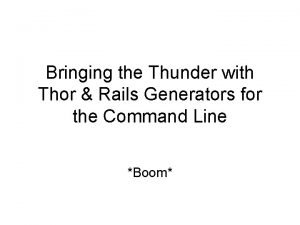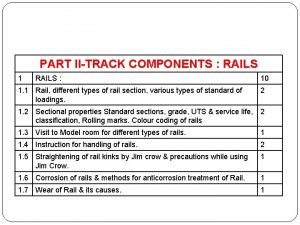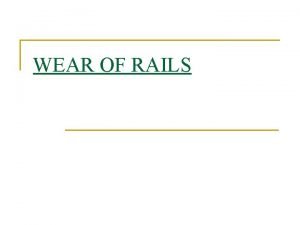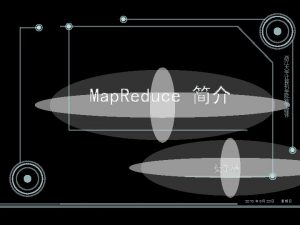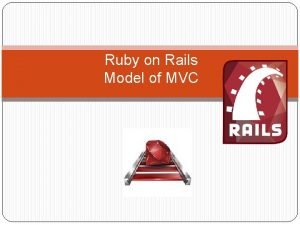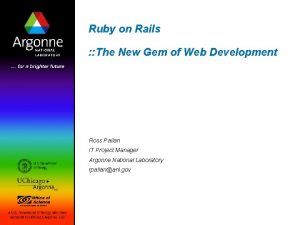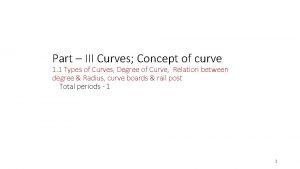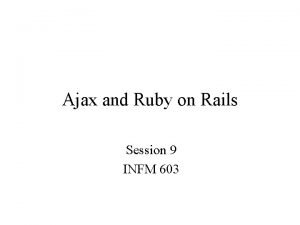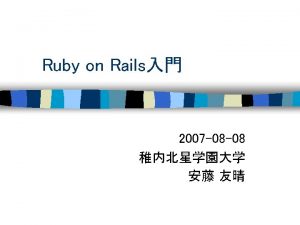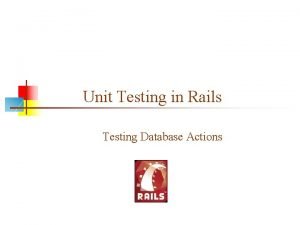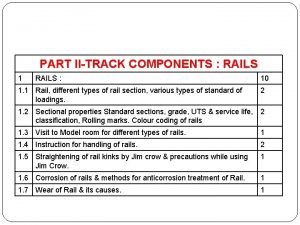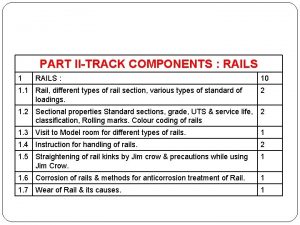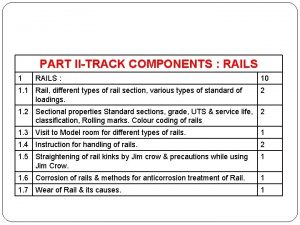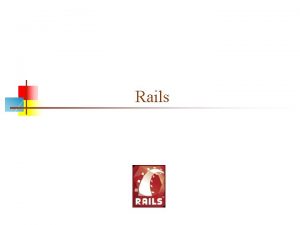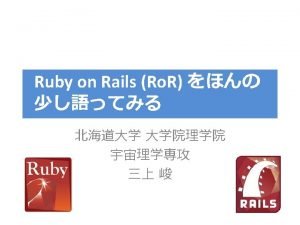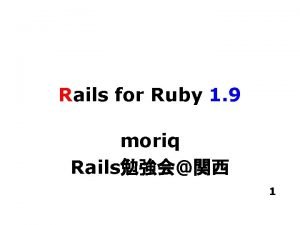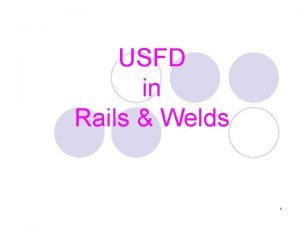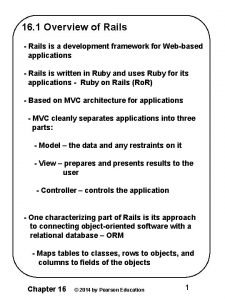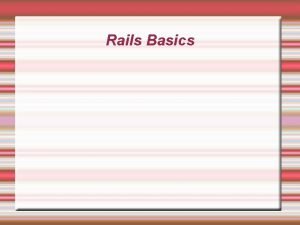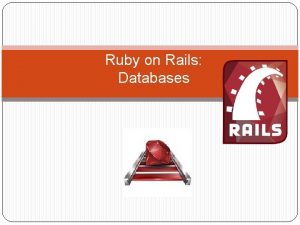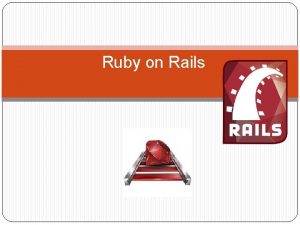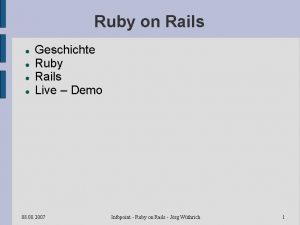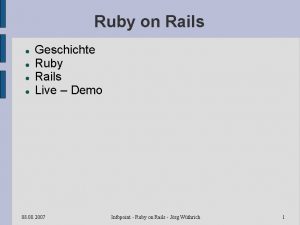PART IITRACK COMPONENTS RAILS 1 RAILS 10 1


















- Slides: 18

PART II-TRACK COMPONENTS : RAILS 1 RAILS : 10 1. 1 Rail, different types of rail section, various types of standard of loadings. 2 1. 2 Sectional properties Standard sections, grade, UTS & service life, classification, Rolling marks. Colour coding of rails 2 1. 3 Visit to Model room for different types of rails. 1 1. 4 Instruction for handling of rails. 2 1. 5 Straightening of rail kinks by Jim crow & precautions while using Jim Crow. 1 1. 6 Corrosion of rails & methods for anticorrosion treatment of Rail. 1 1. 7 Wear of Rail & its causes. 1

RAILS 1. Rail, different types of rail 1 section, various types of standard of loadings. 2

FUNCTIONS OF RAIL • Provide continuous and level surface for movement of trains. • Provide a pathway which is smooth and has a very less friction. • Bear the stress developed due to vertical loads transmitted to it through axles and wheels as well as breaking forces and thermal stresses. • Carry out the functions of transmitting the load to a large area of formation through sleeper and ballast.

Different types of rails • • Double headed (DH) Bull headed (BH) Flat footed (FF) Flat footed rails has been standardized on Indian Railway.

RAILS Rails v Double Headed Rail v Bull Headed Rail v Flat Footed Rail

Flat footed Rail Sections IRS 52 kg/m UIC 60 kg/m 60 E 1 R 260 ZU 1 -60 Profile (73 kg/m) 136 RE 14 (68 kg/m)





Standard Rail Sections Decided on various consideration. (i)Heaviest axle load. (ii)Maximum permissible speed. Standard Rail Sections used in Indian railways are 60 KG, 52 KG, 90 R, 75 R and 60 R. The standard rail section and the standard rail length prescribed in Indian Railways are given below.

Standard Rail Sections • For 60 kg and 52 Kg GAUGE RAIL TYPE OF Weight SECTION (in kg/m ) Area of Cross section (in cm²) BG 60 kg/m UIC 60. 34 76. 86 52 kg/m IRS 51. 89 66. 15

Recommended Rail Section– • Main line– Track Renewals, Doubling, New Lines and Gauge Conversions– 60 kg/m rails with minimum 90 UTS • Note– For Gauge Conversion works & new line works having projected traffic of less than 5 GMT, 60 kg/m (SH) rails, if available with Railways, can be used depending upon future projected extension of lines etc. • (2) Loop Lines– • Renewal of loop lines is to be done with 60 kg/m (SH) or 52 kg/m (SH) rails. The new rails can also be used for these rail renewals with prior approval of Railway Board.

Recommended Rail Section. . (Contd. . ) • Private and other sidings– (i) Sidings taking off from DFC or feeder routes to 60 kg/m DFC or 25 t axle load routes. Sidings other than (i) above; (ii) With permissible speed up to 50 km/h. 52 kg/m (SH); or 52 kg/m (IU) Sidings other than (i) above; (iii) With permissible speed more than 50 km/h. 60 kg/m

Loading standards • In Indian Railway the loading standards have been given mainly for bridge design such as: • BGML loading; • RBG Loading; • MBG loading; • 25 T loading and • DFC loading. However for track it is given in terms of axle load. (contd…)

Loading standards. . Contd. . • • 18. 5 T axle load 20. 32 T axle load 22. 38 tonne axle load CC+6+2 i. e 22. 32 tonnes CC+8+2 i. e max. 22. 9 tonnes 25 T 32. 5 T (DFCCIL)

Suitability of Rails for different standard of loading • For higher axle load, higher section rails are to be used as per instructions issued by Railway Board/RDSO. • For 25 T axle load min rail section to be 60 Kg 90 UTS • For 32. 5 T DFC loading, min Rail section to be 60 Kg, 110 UTS or 68 Kg 110 UTS rail.

THANKS
 üdc
üdc Influxdb collectd
Influxdb collectd Seizure precautions bed rails
Seizure precautions bed rails Rails sms
Rails sms Thor rails
Thor rails Rocket sled on rails
Rocket sled on rails Apache ruby
Apache ruby Flat footed rail
Flat footed rail Continuous tubular rails
Continuous tubular rails Wear of rails
Wear of rails Shock blocks placed under the foot of the bed
Shock blocks placed under the foot of the bed Java awk
Java awk Ruby on rails model view controller
Ruby on rails model view controller Dhh rails
Dhh rails Jonathan ruby
Jonathan ruby Versine
Versine Rails session model
Rails session model Ruby on rails demo
Ruby on rails demo Rails test database
Rails test database




